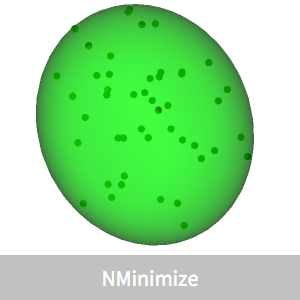Max-Cut Problem
The max-cut problem determines a subset  of the vertices
of the vertices  of a graph, for which the sum of the weights
of a graph, for which the sum of the weights  of the edges that cross from
of the edges that cross from  to its complement
to its complement  is maximized.
is maximized.
This example demonstrates how SemidefiniteOptimization may be used to set up a function that efficiently solves a relaxation of the NP-complete max-cut problem.
Suppose that  has
has  vertices so that they can be described by an index
vertices so that they can be described by an index  . Let
. Let  be a vector with components
be a vector with components  for
for  and
and  for
for  so that
so that  is nonzero (=2) only if
is nonzero (=2) only if  and
and  . Thus the max-cut is found by maximizing
. Thus the max-cut is found by maximizing  , where
, where  . The objective can be rewritten as:
. The objective can be rewritten as:

... where  is the Laplacian matrix of the graph and
is the Laplacian matrix of the graph and  is the weighted adjacency matrix.
is the weighted adjacency matrix.
For smaller cases, the max-cut problem can be solved exactly, but this is impractical for larger graphs since in general the problem has NP-complete complexity.
The problem minimizes  , where
, where  is a symmetric rank-1 positive semidefinite matrix, with
is a symmetric rank-1 positive semidefinite matrix, with  for each
for each  , equivalent to
, equivalent to  , where
, where  is the matrix with
is the matrix with  at the
at the  diagonal position and 0 everywhere else.
diagonal position and 0 everywhere else.
To make the solution practical, solve a relaxed problem where the rank-1 condition is eliminated so that it only requires  .
.
The semidefinite problem in dual form is given by

It is solved using SemidefiniteOptimization[c, {a0, a1, …, ak}, {"DualMaximizer" }].
For the solution  of the relaxed problem, a cut is constructed by randomized rounding: decompose
of the relaxed problem, a cut is constructed by randomized rounding: decompose  , let
, let  be a uniformly distributed random vector of the unit norm and let
be a uniformly distributed random vector of the unit norm and let  . For demonstration, a function is defined that shows the relaxed value, the rounded value and the graph, with the vertices in
. For demonstration, a function is defined that shows the relaxed value, the rounded value and the graph, with the vertices in  shown in red.
shown in red.
Find an approximate max cut using the previously shown procedure, and compare with the exact result.
Find the max cut for a grid graph.
Find the max cut for a random graph.
Compare timings for the relaxed and exact algorithms for a Peterson graph.






















